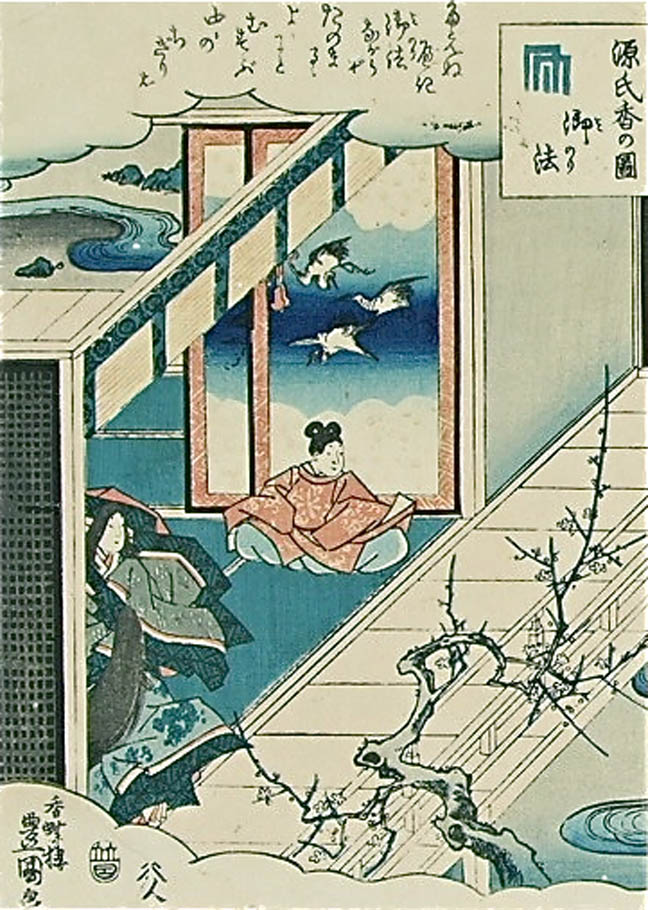

Title: The Tale of the Gengi: Japanese Woodblock Print by Artist Kunisada
Shipping: $18.00
Artist: N/A
Period: 19th Century
History: N/A
Origin: N/A
Condition: Good
Item Date: 1800 to 1900
Item ID: 1851
Unframed Japanese woodblock print in colors, by the artist Kunisada. This beautiful, antique woodcut is printed on hand made-paper, full of vibrant color and strong outlines. It depicts a Japanese home with all of its splendor. "The Tale of the Gengi," chuban size, approximately 10-1/8" x 7-3/8", hinged into a mat but not framed. Condition: Some surface wear, creases, stains. This particularKunisada print has some worming. We are committed to enhancing our customer’s lives by discovering creating, and pointing out only the best art we can find in the world today. We Are Taste-Makers, Art Advisers & Consultants.
Link: http://en.wikipedia.org/wiki/Woodblock_printing
Woodblock printing is a technique for printing text, images or patterns used widely throughout East Asia and originating in China in antiquity as a method of printing on textiles and later paper. As a method of printing on cloth, the earliest surviving examples from China date to before 220, and from Egypt to the 4th century. Ukiyo-e is the best known type of Japanese woodblock art print. Most European uses of the technique on paper are covered by the art term woodcut, except for the block-books produced mainly in the fifteenth century. The wood block is prepared as a relief matrix, which means the areas to show 'white' are cut away with a knife, chisel, or sandpaper leaving the characters or image to show in 'black' at the original surface level. The block was cut along the grain of the wood. It is only necessary to ink the block and bring it into firm and even contact with the paper or cloth to achieve an acceptable print. The content would of course print "in reverse" or mirror-image, a further complication when text was involved. The art of carving the woodcut is technically known as xylography, though the term is rarely used in English.
For colour printing, multiple blocks are used, each for one colour, although overprinting two colours may produce further colours on the print. Multiple colours can be printed by keying the paper to a frame around the woodblocks. There are three methods of printing to consider:
Stamping: Used for many fabrics, and most early European woodcuts (1400-40) These were printed by putting the paper or fabric on a table or other flat surface with the block on top, and pressing or hammering the back of the block. Young monks printing Buddhist scriptures using the rubbing technique, Sera Monastery, Tibet Rubbing: Apparently the most common for Far Eastern printing on paper at all times. Used for European woodcuts and block-books later in the fifteenth century, and very widely for cloth. The block goes face up on a table, with the paper or fabric on top. The back is rubbed with a "hard pad, a flat piece of wood, a burnisher, or a leather frotton".
Printing in a press: Presses only seem to have been used in Asia in relatively recent times. Simple weighted presses may have been used in Europe, but firm evidence is lacking. Later, printing-presses were used (from about 1480). A deceased Abbess of Mechelen in Flanders in 1465 had "unum instrumentum ad imprintendum scripturas et ymagines … cum 14 aliis lapideis printis" ("an instrument for printing texts and pictures … with 14 stones for printing") which is probably too early to be a Gutenberg-type printing press in that location. In addition, jia xie is a method for dyeing textiles (usually silk) using wood blocks invented in the 5th-6th centuries in China. An upper and a lower block is made, with carved out compartments opening to the back, fitted with plugs. The cloth, usually folded a number of times, is inserted and clamped between the two blocks. By unplugging the different compartments and filling them with dyes of different colours, a multi-coloured pattern can be printed over quite a large area of folded cloth. The method is not strictly printing however, as the pattern is not caused by pressure against the block.